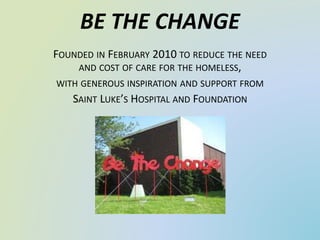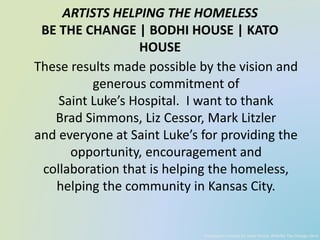The document summarizes the work of Artists Helping the Homeless (AHH) programs in Kansas City, including Be The Change, Bodhi House, and plans for Kato House and Kato Clinic. It discusses:
- AHH was founded in 2010 to reduce homelessness and costs, supported by Saint Luke's Hospital.
- Programs provide transportation, housing, advocacy, and help people access services to improve outcomes. This has saved over $10 million in emergency costs.
- Future plans include Kato House for transitional youth and Kato Clinic to provide on-site medical care.


![A DIFFERENT APPROACH TO THE TRADITIONAL TRANSFER OF CASE MANAGEMENT FROM AGENCY TO AGENCY
PROGRAM PRINCIPLES
PROVIDE AID WITH RESPECT
PROVIDE ADVOCACY FOR THOSE WANTING TO GET OFF THE STREET
ADDRESS UNDERLYING CAUSES
COLLABORATE, NOT DUPLICATE EXISTING SERVICES
RAISE AWARENESS
NOT FACILITY-BASED
Works with clients where they are, literally and figuratively, in emergency and homeless services facilities
Improve outcomes and efficiency
Work with homeless to tackle systemic challenges
WORKS WITH CLIENTS THROUGHOUT THE PROCESS
Adapt individual plans for progress and challenges
[Example – Client relapsed Friday, called Saturday – admitted himself to KCCC to get back on plan rather than staying on the street
until crisis prompted change]
Address multiple issues concurrently which improves outcomes
Coordinates care and avoids crisis-driven provider selection
Provides consistency throughout the recovery and reintegration process
Intensive Street Presence and Collaboration expands the reach of collaborating agencies
Approach combines Housing First and Recovery Oriented System of Care (ROSC) with a Collective Impact perspective
Today, the BE THE CHANGE program works with people from all sections of Kansas City’s homeless population to:
Meet immediate needs
Eliminate barriers such as finding and accessing housing, medical/mental treatment, etc.
Domestic violence victims, stranded travelers, just released homeless hospital patients
Often involves the chronic homeless that have fallen through the service safety net
SEVERAL INITIATIVES HAVE BEEN CREATED TO ADDRESS COMMON ISSUES FOR CLIENTS AND THE AGENCIES THAT SERVE THEM……](https://image.slidesharecdn.com/ad7bcb09-9282-4a7a-a65b-c65bd12d6d2e-150611042800-lva1-app6892/85/AHH-PPT-6-2-15-3-320.jpg)














